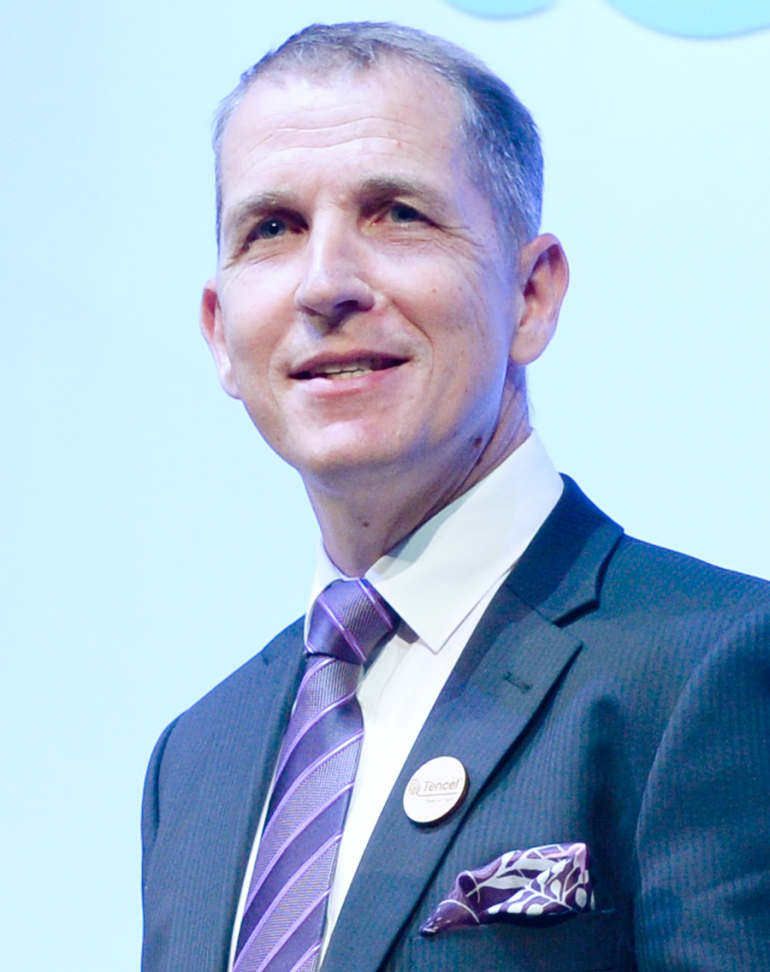Behind every brand delivering a great experience is a leader who recognizes the value of keeping things simple. In Simplifiers, Margaret Molloy, our Global CMO, interviews business leaders who put simplicity to work.
In this Simplifiers interview, Margaret speaks with Harold Weghorst, Executive Director of Global Marketing, Lenzing. Based in Austria, The Lenzing Group is an international company of wood-based cellulose fibers, with over 6,000 employees, and €2.26 billion in annual revenue.
MM: What does your brand stand for, and how does it deliver on that promise every day?
HW: Our three product brands stand for sustainability and performance. For 80 years, Lenzing has created smart and exciting solutions made from natural origin, from wood—for consumers, for our business partners and for an environment worth living in.
TENCEL™ is Lenzing’s flagship brand for textiles. Its brand promise centers around the tagline “feels so right,” because the fibers are naturally soft to the touch, offer long-lasting comfort and are environmentally friendly.
VEOCEL™, our premium brand for nonwoven products, such as wet wipes, facial sheet masks, and cosmetic pads, is built around a promise of offering everyday natural care and also contributes to a better environment.
LENZING™ is our specialty B2B brand, developed to meet the needs of industry with smart solutions from natural origin.
MM: What role does simplicity play in delivering on that promise?
HW: Simplicity is the key to the success of our value propositions. A brand promise needs to be clear, relevant and ownable. As a company, we are dedicated to preserving our planet’s resources; sustainability is in our DNA. The simplicity in that promise applies to our brand and to our products. It’s something that drives me and many of my colleagues and it’s also in sync with what the market needs.
MM: How does your organization strive to create simple experiences?
HW: To create simple experiences, we had to define our brands first. We lacked clarity, relevance, and consistency, making it difficult for employees to describe our brands in a concise manner. If our own people lacked an understanding of our brands, imagine how our customers or consumers felt. Our new brand strategy is not only relevant to our consumers and customers, on-top it provides employees with a clear, identifiable and relatable promise.
MM: What benefits has your company experienced from simplifying?
HW: A simplified brand strategy and brand portfolio help consumers, customers and other stakeholders easily understand what Lenzing stands for. In the short run, it’s about change, which requires a lot of effort, both externally and internally. In the long run, we see great benefits from reducing the complexity of our brand portfolio and generating demand from consumers.
“In terms of simplicity, the business of marketing strategy is all about making choices. But besides what to do, I think many people forget that it’s also about deciding what not to do.”
MM: How do you strive to keep things “simple” for your marketing team every day? What’s working?
HW: Simplicity not only applies to brand strategy, but it applies to business practices in general. While it’s not easy condensing your message down to a few bullet points, it pays off in the end. I think it was Winston Churchill who once apologized to a friend saying, “If I had more time I would have written you a shorter letter.” Focus means more effort, but it also means more impact.
MM: How do you lead as a simplifier?
HW: I try to keep things simple for my team by having single-minded objectives, strategies, and messages. I use this practice to guide the business. With so many distractions and tempting opportunities around us, it’s crucial to keep your eye on the ball and stay focused on your goals. That concentration allows us to simplify and prioritize our actions.
MM: Do you worry about missing out?
HW: It’s important to be open to what is happening around you with regards to trends, technology, and techniques. In filtering those, it helps to have a clear purpose and objective. That’s my compass.
MM: What’s the most recent, simple customer experience that inspired you?
HW: I relate to brands that have very simple, straightforward and inspiring brand promises, such as Patagonia or Apple.
MM: What is the biggest mistake brands make with regard to simplifying?
HW: I think the biggest mistake is not sticking to simplification. As a company, you need a clear vision—where you want to go and then, burn rubber on the implementation. The business of marketing strategy is all about making choices. But besides what to do, I think many people forget that it’s also about deciding what not to do.
MM: What are the key indicators that simplicity is driving your business?
HW: Our new brand strategy resulted in a clarity that guides our daily actions. We have turned this strategic progress into positioning and messaging for our masterbrand and product brands, enabling us to drive it both internally and externally. We have a great innovation pipeline, quality focus and contribute to a more sustainable world. I believe the simplicity of this strategy is really driving our business.
MM: What’s a time that you made a difficult decision for the sake of simplicity?
HW: Rationalizing our brand portfolio is a great example. We faced many challenges over which brands to keep. Sometimes there were even good reasons and valid arguments. However, if you have a clear vision, you must hold on to it. In hindsight, I’m glad we were able to withstand the temptation and not stray from our vision.
MM: What does “simplicity” mean to you?
HW: Simplicity means focusing on what counts.
MM: What is the top piece of advice you’d give to other brands trying to simplify?
HW: Simplify or die. When done correctly, simplification pays off, providing brands with direction and purpose.
MM: Thank you.
Know a Simplifier or would like to be included in the series? Please recommend an executive for my next interview: [email protected]
Margaret Molloy is Global CMO and head of business development at Siegel+Gale. Follow her on Twitter: @MargaretMolloy
Simplifiers is an ongoing series. See interviews with CMO at Deloitte, Diana O’Brien; CMO at Georgia-Pacific, Douwe Bergsma; CMO at Lenovo, David Roman; EVP – Chief Marketing and Communications Officer at Hewlett Packard Enterprise, Henry Gomez; CMO at Twitter, Leslie Berland; CMO at Blue Apron, Jared Cluff; SVP, Global Brand Management at American Express, Clayton Ruebensaal; EVP and Group President at Verizon Wireless, Ronan Dunne; Director of Strategy and Innovation at Cofra Holding Ltd, former CEO of C&A China, Lawrence Brenninkmeyer; CMO at The Recording Academy, Evan Greene; CMO at Mary Kay, Sheryl Adkins-Green; Head of Marketing at Home Centre, Rohit Singh Bhatia; SVP, CMO of Aflac, Gail Galuppo; SVP and CMO at Cambia Health Solutions, Carol Kruse; Managing Director of The Nature Conservancy, Geof Rochester; Chief Strategy and Innovation Officer of Motorola Solutions, Eduardo Conrado; EVP; SVP, Chief Marketing & External Affairs Officer at Abbott, Elaine Leavenworth; GE CMO, Linda Boff; McLaren Automotive Head of Brand Marketing, Stephen Lambert; Ascension Chief Marketing and Communications Officer, Nick Ragone; Hertz CMO, Matt Jauchius; Direct Line Group Marketing Director, Mark Evans; McDonald’s CMO, Deborah Wahl; Jet.com President, Liza Landsman and VP Marketing, Sumaiya Balbale; Target CMO, Jeff Jones; Spotify CMO, Seth Farbman; Ally Financial CMO, Andrea Riley; Gannett CMO, Andy Yost; CVS Health CMO, Norman De Greve; Dunkin’ Brands CMO, John Costello; Zappos CEO, Tony Hsieh; Southwest Airlines CMO, Kevin Krone; and Google CMO, Lorraine Twohill.


